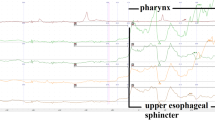Summary
Oesophageal sphincter measurements were carried out on 80 patients using the stationary pull through technique; Normals (n=21), Nutcracker (n=12), Refluxers (n=21), and Barrett’s (n=26). Sphincter pressure (LOSP), abdominal length of sphincter, and overall sphincter length were measured. The Sphincter Function Index (SFI) was calculated as the product of sphincter pressure and percentage sphincter length (AL) exposed to abdominal pressure. Patients also had routine endoscopy and 24 hour pHmetry. SFI values discriminated between all four groups. LOSP was significantly different for Barrett’s (p<0.01) and Nutcracker (p<0.01) compared to normals. AL was significant for Refluxers (p<0.001) and Barrett’s (p<0.001) compared to normals. SFI gives better discrimination than LOSP or AL alone and may be useful in evaluating the response to treatment.
Similar content being viewed by others
References
DeMeester, T. R., Wernly, J. A., Bryant, G. H., Little, A. G., Skinner, D. B. Clinical and in-vitro analysis of determinants of gastroesophageal competence. Amer. J. Surg 1979; 137: 39–46.
Zaninotto, G., DeMeester, T. R., Schwizer, W., Johansson, K. E., Cheng, S. C. The lower esophageal sphincter in health and disease. Amer. J. Surg. 1988; 155: 104–111.
Goyal, R. K., Paterson, W. G. Esophageal Motility. In: Handbook of Physiology, Wood, J., Bethesda, M. D. Eds: American Physiological Society 1988.
Dent, J., Dodds, W. J., Sekiguchi, T., Hogan, W. J., Amdorfer, R. C. Interdigestive phasic contractions of the human lower esophageal sphincter. Gastroenterology 1983; 84: 453–60.
Goyal, R. K., Ratten, S. Neurohumoral, hormonal and drug receptors for the lower esophageal sphincter. Progress in Gastroenterology 1978; 74: 598–619.
Ogilvie, A. L., Atkinson, M. Influence of the vagus nerve Upon the reflux control of the lower oesophageal sphincter. Gut 1984; 25: 253–258.
Dent, J., Dodds, W. J., Friedman, R. H., Sekiguchi, T., Hogan, W. J., Arndorfer, R. C., Petrie, D. J. Mechanism of gastroesophageal reflux in recumbent asymptomatic human subjects. J. Clin. Invest. 1980; 65: 256–267.
Mughal, M. M., Bancewicz, J., Marples, M. Oesophageal manometry and pH recording does not predict the bad results of Nissen fundoplication. Br. J. Surg. 1990; 77: 43–45.
Bonavini, L., Evander, A., DeMeester, et al. Length of the distal esophageal sphincter and competency of the cardia. Am. J. Surg. 1986; 151: 25–34.
Boesby, S. Relationshipbetweengastroesophagealacidreflux, basal gastroesophageal sphincter pressure and gastric acid secretion. Scand. J. Gastroenterol. 1977; 12: 547–551.
Siegel, C. I., Hendrix, T. R. Esophageal motor abnormalities induced by acid perfusion in patients with heartburn. J. Clin. Invest. 1963; 42: 686–695.
Waterman, D. C., Dalton, C. B., Ott, D. et al. The hypertensive lower oesophageal sphincter: what does it mean? J. Clin. Gastroenterol. 1989; 11: 139–143.
Author information
Authors and Affiliations
Rights and permissions
About this article
Cite this article
Byrne, P.J., Stuart, R.C., Lawlor, P. et al. A new technique for measuring lower oesophageal sphincter competence in patients. I.J.M.S. 162, 351–354 (1993). https://doi.org/10.1007/BF02942165
Issue Date:
DOI: https://doi.org/10.1007/BF02942165




